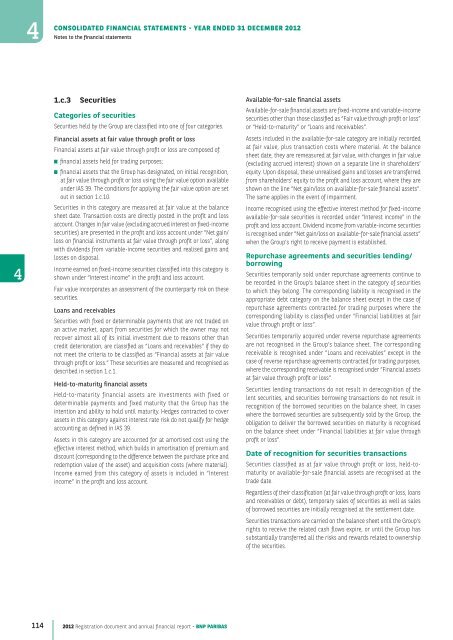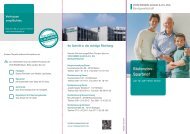2012 Registration document and annual financial report - BNP Paribas
2012 Registration document and annual financial report - BNP Paribas
2012 Registration document and annual financial report - BNP Paribas
- No tags were found...
Create successful ePaper yourself
Turn your PDF publications into a flip-book with our unique Google optimized e-Paper software.
4CONSOLIDATEDFINANCIAL STATEMENTS - YEAR ENDED 31 DECEMBER <strong>2012</strong>Notes to the <strong>financial</strong> statements41.c.3SecuritiesCategories of securitiesSecurities held by the Group are classified into one of four categories.Financial assets at fair value through profit or lossFinancial assets at fair value through profit or loss are composed of:■ <strong>financial</strong> assets held for trading purposes;■ <strong>financial</strong> assets that the Group has designated, on initial recognition,at fair value through profit or loss using the fair value option availableunder IAS 39. The conditions for applying the fair value option are setout in section 1.c.10.Securities in this category are measured at fair value at the balancesheet date. Transaction costs are directly posted in the profit <strong>and</strong> lossaccount. Changes in fair value (excluding accrued interest on fixed-incomesecurities) are presented in the profit <strong>and</strong> loss account under “Net gain/loss on <strong>financial</strong> instruments at fair value through profit or loss”, alongwith dividends from variable-income securities <strong>and</strong> realised gains <strong>and</strong>losses on disposal.Income earned on fixed-income securities classified into this category isshown under “Interest income” in the profit <strong>and</strong> loss account.Fair value incorporates an assessment of the counterparty risk on thesesecurities.Loans <strong>and</strong> receivablesSecurities with fixed or determinable payments that are not traded onan active market, apart from securities for which the owner may notrecover almost all of its initial investment due to reasons other thancredit deterioration, are classified as “Loans <strong>and</strong> receivables” if they donot meet the criteria to be classified as “Financial assets at fair valuethrough profit or loss.” These securities are measured <strong>and</strong> recognised asdescribed in section 1.c.1.Held-to-maturity <strong>financial</strong> assetsHeld-to-maturity <strong>financial</strong> assets are investments with fixed ordeterminable payments <strong>and</strong> fixed maturity that the Group has theintention <strong>and</strong> ability to hold until maturity. Hedges contracted to coverassets in this category against interest rate risk do not qualify for hedgeaccounting as defined in IAS 39.Assets in this category are accounted for at amortised cost using theeffective interest method, which builds in amortisation of premium <strong>and</strong>discount (corresponding to the difference between the purchase price <strong>and</strong>redemption value of the asset) <strong>and</strong> acquisition costs (where material).Income earned from this category of assets is included in “Interestincome” in the profit <strong>and</strong> loss account.Available-for-sale <strong>financial</strong> assetsAvailable-for-sale <strong>financial</strong> assets are fixed-income <strong>and</strong> variable-incomesecurities other than those classified as “F air value through profit or loss”or “H eld-to-maturity” or “L oans <strong>and</strong> receivables”.Assets included in the available-for-sale category are initially recordedat fair value, plus transaction costs where material. At the balancesheet date, they are remeasured at fair value, with changes in fair value(excluding accrued interest) shown on a separate line in shareholders’equity. Upon disposal, these unrealised gains <strong>and</strong> losses are transferredfrom shareholders’ equity to the profit <strong>and</strong> loss account, where they areshown on the line “Net gain/loss on available-for-sale <strong>financial</strong> assets”.The same applies in the event of impairment.Income recognised using the effective interest method for fixed-incomeavailable-for-sale securities is recorded under “Interest income” in theprofit <strong>and</strong> loss account. Dividend income from variable-income securitiesis recognised under “Net gain/loss on available-for-sale <strong>financial</strong> assets”when the Group’s right to receive payment is established.Repurchase agreements <strong>and</strong> securities lending/borrowingSecurities temporarily sold under repurchase agreements continue tobe recorded in the Group’s balance sheet in the category of securitiesto which they belong. The corresponding liability is recognised in theappropriate debt category on the balance sheet except in the case ofrepurchase agreements contracted for trading purposes where thecorresponding liability is classified under “Financial liabilities at fairvalue through profit or loss”.Securities temporarily acquired under reverse repurchase agreementsare not recognised in the Group’s balance sheet. The correspondingreceivable is recognised under “Loans <strong>and</strong> receivables” except in thecase of reverse repurchase agreements contracted for trading purposes,where the corresponding receivable is recognised under “Financial assetsat fair value through profit or loss”.Securities lending transactions do not result in derecognition of thelent securities, <strong>and</strong> securities borrowing transactions do not result inrecognition of the borrowed securities on the balance sheet. In caseswhere the borrowed securities are subsequently sold by the Group, theobligation to deliver the borrowed securities on maturity is recognisedon the balance sheet under “Financial liabilities at fair value throughprofit or loss”.Date of recognition for securities transactionsSecurities classified as at fair value through profit or loss, held-tomaturityor available-for-sale <strong>financial</strong> assets are recognised at thetrade date.Regardless of their classification (at fair value through profit or loss, loans<strong>and</strong> receivables or debt), temporary sales of securities as well as salesof borrowed securities are initially recognised at the settlement date.Securities transactions are carried on the balance sheet until the Group’srights to receive the related cash flows expire, or until the Group hassubstantially transferred all the risks <strong>and</strong> rewards related to ownershipof the securities.114<strong>2012</strong> <strong>Registration</strong> <strong>document</strong> <strong>and</strong> <strong>annual</strong> <strong>financial</strong> <strong>report</strong> - <strong>BNP</strong> PARIBAS





